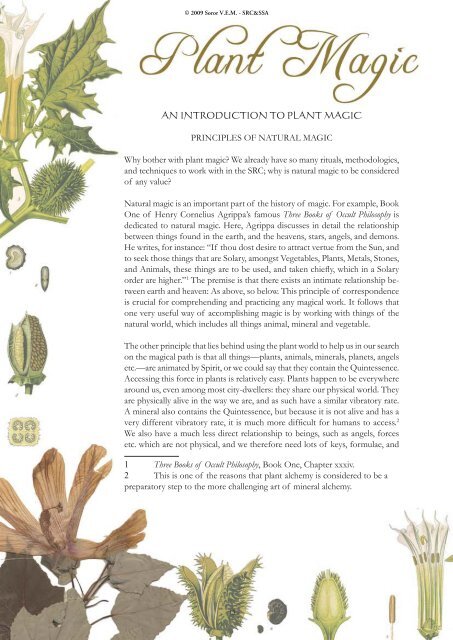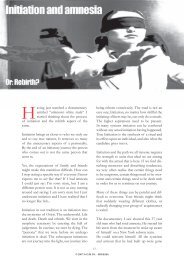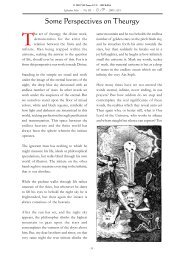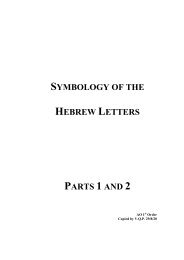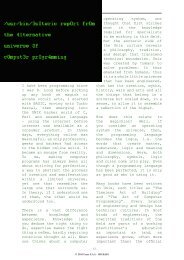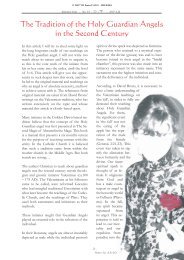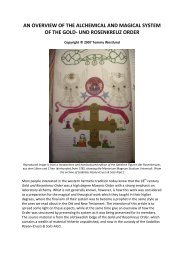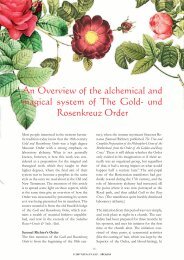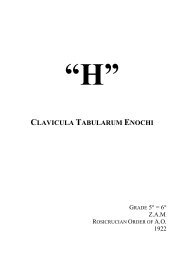An Introduction to Plant Magic - Sodalitas Rosae+Crucis & Solis Alati
An Introduction to Plant Magic - Sodalitas Rosae+Crucis & Solis Alati
An Introduction to Plant Magic - Sodalitas Rosae+Crucis & Solis Alati
Create successful ePaper yourself
Turn your PDF publications into a flip-book with our unique Google optimized e-Paper software.
© 2009 Soror V.E.M. - SRC&SSA<br />
AN INTRODUCTION TO PLANT MAGIC<br />
PRINCIPLES OF NATURAL MAGIC<br />
Why bother with plant magic? We already have so many rituals, methodologies,<br />
and techniques <strong>to</strong> work with in the SRC; why is natural magic <strong>to</strong> be considered<br />
of any value?<br />
Natural magic is an important part of the his<strong>to</strong>ry of magic. For example, Book<br />
One of Henry Cornelius Agrippa’s famous Three Books of Occult Philosophy is<br />
dedicated <strong>to</strong> natural magic. Here, Agrippa discusses in detail the relationship<br />
between things found in the earth, and the heavens, stars, angels, and demons.<br />
He writes, for instance: “If thou dost desire <strong>to</strong> attract vertue from the Sun, and<br />
<strong>to</strong> seek those things that are Solary, amongst Vegetables, <strong>Plant</strong>s, Metals, S<strong>to</strong>nes,<br />
and <strong>An</strong>imals, these things are <strong>to</strong> be used, and taken chiefly, which in a Solary<br />
order are higher.” 1 The premise is that there exists an intimate relationship between<br />
earth and heaven: As above, so below. This principle of correspondence<br />
is crucial for comprehending and practicing any magical work. It follows that<br />
one very useful way of accomplishing magic is by working with things of the<br />
natural world, which includes all things animal, mineral and vegetable.<br />
The other principle that lies behind using the plant world <strong>to</strong> help us in our search<br />
on the magical path is that all things—plants, animals, minerals, planets, angels<br />
etc.—are animated by Spirit, or we could say that they contain the Quintessence.<br />
Accessing this force in plants is relatively easy. <strong>Plant</strong>s happen <strong>to</strong> be everywhere<br />
around us, even among most city-dwellers: they share our physical world. They<br />
are physically alive in the way we are, and as such have a similar vibra<strong>to</strong>ry rate.<br />
A mineral also contains the Quintessence, but because it is not alive and has a<br />
very different vibra<strong>to</strong>ry rate, it is much more difficult for humans <strong>to</strong> access. 2<br />
We also have a much less direct relationship <strong>to</strong> beings, such as angels, forces<br />
etc. which are not physical, and we therefore need lots of keys, formulae, and<br />
1 Three Books of Occult Philosophy, Book One, Chapter xxxiv.<br />
2 This is one of the reasons that plant alchemy is considered <strong>to</strong> be a<br />
prepara<strong>to</strong>ry step <strong>to</strong> the more challenging art of mineral alchemy.<br />
- 13 -
© 2009 Soror V.E.M. - SRC&SSA<br />
Splendor <strong>Solis</strong> - No. IX- ! i j - 2008A.D.<br />
rituals <strong>to</strong> reach them. For these reasons,<br />
plant magic has the great advantage of<br />
being a very direct route <strong>to</strong> access a particular<br />
force.<br />
Nevertheless, just like any other magical<br />
practice, it is only through much determination<br />
and patience that an aspiring<br />
magician can be allowed <strong>to</strong> penetrate<br />
the many secrets and mysteries that the<br />
plant world offers. To understand the<br />
nature of plants, the correct state of<br />
mind is crucial: it is the Higher within<br />
us that must resonate with the Higher<br />
in the plant. Thus, working with plants<br />
becomes another method of mystical<br />
practice, as well as magical. By slowing<br />
the thoughts and by temporarily ceasing<br />
the endless internal chatter in our minds,<br />
we can achieve a state in which it is possible<br />
<strong>to</strong> speak directly <strong>to</strong> nature, and allow<br />
nature <strong>to</strong> speak <strong>to</strong> us.<br />
Incense<br />
Why are incenses valuable in magic? One<br />
reason is that we want <strong>to</strong> stimulate the<br />
sense of smell. The sense of smell is very<br />
important in our lives and holds a large<br />
reservoir of potential power. If you can<br />
conjure up the smell of your house when<br />
you were young, or of your mother, or<br />
perhaps of a lover you once had, you can<br />
see how smell is a key <strong>to</strong> open the door<br />
of imagination and emotion. In ritual,<br />
we try <strong>to</strong> influence all of our senses as<br />
much as possible <strong>to</strong> get our imagination<br />
going, and <strong>to</strong> make the experience pervade<br />
us completely. This can increase our focus<br />
and give more power <strong>to</strong> what we are trying<br />
<strong>to</strong> accomplish. None of it is strictly necessary,<br />
but it is helpful <strong>to</strong> have props <strong>to</strong> keep<br />
the conscious mind aware of what it is trying<br />
<strong>to</strong> do, and at the same time activate the<br />
subconscious. Incense, then, is one way <strong>to</strong><br />
help create a particular environment. Usually<br />
a good incense gives just that extra “spark”<br />
<strong>to</strong> a ritual.<br />
In addition, incenses are (mostly) composed<br />
of plants, and following the principle of<br />
correspondence as mentioned above, each<br />
plant has attributions <strong>to</strong> elemental, zodiacal,<br />
planetary, and even angelic forces. Depending<br />
on the source, these attributions can vary,<br />
but many tend <strong>to</strong> be agreed upon. Marigold<br />
(Calendula officinalis) 3 , for example, is almost<br />
always attributed the qualities of the Sun,<br />
not only because it is brightly colored and<br />
opens and closes with the Sun, but because<br />
it cheers and strengthens the heart and comforts<br />
the spirit. I would remind the reader,<br />
however, that these magical attributions are<br />
not always just intellectual ideas that people<br />
have placed on<strong>to</strong> the plant because the plant<br />
“reminds” them of a planet (although that<br />
happens in the literature as well). On the<br />
contrary, I would argue that the best magical<br />
understanding of the correspondence<br />
between a species of the plant world and a<br />
planet and/or zodiacal sign came about due<br />
<strong>to</strong> a deep comprehension as <strong>to</strong> the nature of<br />
3 In this essay, I will be giving the English<br />
name for the plant, followed by the Latin. Those<br />
of you who are curious can find the plant’s name in<br />
your own language by looking up the Latin name.<br />
- 14 -
© 2009 Soror V.E.M. - SRC&SSA<br />
Splendor <strong>Solis</strong> - No. IX- ! i j - 2008A.D.<br />
both. <strong>An</strong> incense composed of these natural elements can act as a<br />
direct line <strong>to</strong> those forces. If you can tap in<strong>to</strong> the properties of a<br />
plant, you can use it <strong>to</strong> great effect.<br />
One of the central methodologies of natural magic is that we<br />
should work with nature, not against it. The main reason for this<br />
is that it is much easier <strong>to</strong> go with the tide than <strong>to</strong> swim against it!<br />
<strong>Magic</strong> takes a lot of energy, and it is counter <strong>to</strong> logic <strong>to</strong> waste any<br />
energy. <strong>An</strong>other reason is that nature knows a vast amount more<br />
than any of us as thinking individuals can possibly know. There are<br />
innumerable patterns in nature, and training <strong>to</strong> read those patterns<br />
is part of the Great Work. Learning <strong>to</strong> gather and work with plants<br />
serves just this purpose. Imposing one’s will on nature is of course<br />
possible, but one should be very clear about why one does such a<br />
thing. The best way <strong>to</strong> start learning from nature is by following<br />
those of her rules that we already know.<br />
So, when you make an incense, you should take in<strong>to</strong> account the<br />
day of the week and where the moon is in its cycle. For example,<br />
if you were <strong>to</strong> make a Solar incense, it is recommended that it is<br />
made on a Sunday when the moon is ascending.The moon should be<br />
ascending for making all incenses, with the exception of Saturnine<br />
and Martian incenses, which are best made during a descending<br />
moon for maximum power. I also recommend making the incense<br />
at the proper planetary hour.<br />
<strong>An</strong>other thing which is even more fundamental <strong>to</strong> making a powerful<br />
incense is the correct intention. See the actual making of<br />
the incense as a magical act. Try <strong>to</strong> make contact with each of the<br />
ingredients you work with, feeling their essence and relating it <strong>to</strong> its corresponding force.<br />
Praying <strong>to</strong> or invoking a force that you associate with the planet while actually making the<br />
incense is a wonderful way <strong>to</strong> put the right kind of energy in<strong>to</strong> it. Believe in what you do as<br />
you do it; the importance of this cannot be emphasized enough.<br />
Dried plant matter can make powerful <strong>to</strong>ols when combined with other plant forms, for<br />
example vegetable oils, essential oils, and wine. They can also be mixed with non-vegetable<br />
matter such as crushed s<strong>to</strong>nes and minerals, honey, musk, and blood.<br />
Some of the most famous incenses are Olibanum/Frankincense, Myrrh,<br />
and Sandalwood, so I will discuss them in a little more detail. Olibanum<br />
(Boswellia thurifera) is used very often by Western magicians. It is a resin, and<br />
we use it not only because it smells absolutely wonderful, but also because<br />
it has natural purifying qualities. It is therefore perfect <strong>to</strong> use when clearing<br />
a space, doing a banishing, or making a circle. Olibanum is included in<br />
many incense recipes from antiquity <strong>to</strong> the present day. The ancient Jews,<br />
Egyptians, Babylonians, Persians, and Assyrians all used it. In terms of<br />
planetary forces, it is found in Sun and Jupiter incenses, as it is very bright<br />
and uplifting in its nature.<br />
- 17 -
© 2009 Soror V.E.M. - SRC&SSA<br />
Splendor <strong>Solis</strong> - No. IX- ! i j - 2008A.D.<br />
Myrrh (Commiphora myrrha) is also a resin, coming<br />
from trees that grow in eastern Africa. It<br />
was used by the ancient Jews and Egyptians, in<br />
incense but also as a medicine and, in the case<br />
of the Egyptians, in embalming. We have a<br />
written record of its use in ancient Egypt from<br />
about 2000 B.C.E., and it is mentioned several<br />
times in both the New and Old Testaments of<br />
the Bible. It is still used medicinally <strong>to</strong> some<br />
extent by herbalists, often as an antiseptic. Its<br />
character is much earthier than Olibanum, and<br />
it is used in Earth and Saturn incenses.<br />
Sandalwood (Santalum album) is the inner bark<br />
of the sandal tree, which grows in India and<br />
other places in Asia. It is the primary ingredient<br />
of incense, as well as oils and perfumes, in that<br />
part of the world. The fragrant wood is also<br />
used in funeral pyres. Its medicinal disinfectant<br />
qualities reside in the oil which is extracted from<br />
the wood, and herbalists still prescribe its use<br />
as an aphrodisiac. This characteristic, as well as<br />
its spicy, fragrant character lends itself <strong>to</strong> Luna<br />
and Venus incenses.<br />
Making incenses with exotic ingredients is a<br />
real pleasure. However, <strong>to</strong> work with plants<br />
and herbs that you have gathered yourself is<br />
not only immensely satisfying, but the very act<br />
of gathering plants by hand gives much greater<br />
power <strong>to</strong> the plants used. There are many<br />
plants in your area, wherever you live. As well<br />
as ingredients in incense, herbs and plants can<br />
be used magically in a great variety of ways: for<br />
protection, for medicine and healing, and for<br />
magical <strong>to</strong>ols. <strong>Plant</strong>s are also used in alchemy,<br />
which can produce the most complete herbal<br />
medicines of all. So, if at all possible, I recommend<br />
using plants you have gathered yourself.<br />
Gathering <strong>Plant</strong>s<br />
The first thing one must do in order <strong>to</strong> pursue<br />
gathering plants is <strong>to</strong> learn about the plant world<br />
in the physical sense. This means studying the<br />
area in which you live and finding out about<br />
the plants that have medicinal or magical value<br />
which grow around you. I must admonish all<br />
potential plant magicians <strong>to</strong> be very careful<br />
about gathering plants, since many plants look<br />
alike, but while some are beneficial, others can<br />
be extremely poisonous. Therefore, taking<br />
the necessary time <strong>to</strong> study plants in order <strong>to</strong><br />
identify them correctly is not only beneficial<br />
in order <strong>to</strong> comprehend the properties of a<br />
plant intellectually, but also compulsory so as<br />
<strong>to</strong> avoid any accidents! It is a good idea <strong>to</strong> start<br />
with only a few plants, so as not <strong>to</strong> feel completely<br />
overwhelmed. I would suggest selecting<br />
perhaps three or four medicinal plants that are<br />
well-known, easy <strong>to</strong> identify, and grow profusely<br />
in your area. Study how they look, where they<br />
grow, and their medicinal properties. It is a good<br />
idea <strong>to</strong> memorize their Latin names.<br />
Once you start researching your chosen plants,<br />
you will see how truly extraordinary they are.<br />
They each have a long, complex his<strong>to</strong>ry, with<br />
associations with various mythologies, literature<br />
(both old and new), folk-medicine, herbal<br />
medicine (from ancient <strong>to</strong> modern), folk tales,<br />
and lots of superstition, as well as their relationships<br />
<strong>to</strong> the planets and other forces. In general,<br />
you will find that most of the cultures and time<br />
periods before the beginning of the Industrial<br />
Revolution had a much deeper understanding<br />
and relationship with nature than our presentday<br />
societies. The reasons for this are quite<br />
obvious; all medicines, soap, cosmetic products<br />
of all kinds, ink, paper, and hundreds of other<br />
things that we take completely for granted were<br />
all made of products found directly in nature. It<br />
follows logically that those cultures and peoples<br />
who were so dependent on nature had a much<br />
closer relationship with it, whether they were<br />
royalty in a great urban center in ancient Egypt<br />
or a medieval <strong>to</strong>wn in England. Therefore, it is<br />
worth exploring these sources at length.<br />
<strong>Plant</strong>s should always be gathered using the<br />
same logic as listed above: that is, gathered on<br />
- 18 -
© 2009 Soror V.E.M. - SRC&SSA<br />
Splendor <strong>Solis</strong> - No. IX- ! i j - 2008A.D.<br />
the proper day, with the moon on the ascent (with the exception of Saturnine and<br />
Martian plants, as always), and preferably at the correct planetary hour. This is even<br />
more important with gathering plants than with making incense. Certain plants love<br />
the full moon and gathering them at this time is ideal; others, mostly Saturnine plants,<br />
will come in<strong>to</strong> their power at the new moon.<br />
Where should you gather your plant? It is important that you do not take any plants<br />
that are near busy roads or large residential areas, for obvious physical reasons: fumes<br />
of cars and other such poisons can contaminate plants, making them potentially <strong>to</strong>xic<br />
and also less potent as magical <strong>to</strong>ols. Other than this very practical advice, it is also<br />
extremely important that the place from which you take the plant “resonates” with<br />
you. We all know instinctively what that means. Certain places, be they houses, streets,<br />
parks, or areas of forest have what we call a “good vibe,” and others less so. We are<br />
drawn <strong>to</strong> some places, and repelled by others. By making this feeling conscious, we<br />
can choose a place in nature that is conducive <strong>to</strong> doing magical work.<br />
Very often it is best <strong>to</strong> explore an uninhabited area first, and create a type of relationship<br />
with it. This can be a city park (if you are a city-dweller without any chance of<br />
getting <strong>to</strong> a forest), but the best is <strong>to</strong> be as far from humans as possible. There are two<br />
reasons for this. Firstly, the less influence humans have on a natural area, the more<br />
nature’s patterns can emerge freely. Humans have a rather negative influence on wild<br />
nature generally, since they tend <strong>to</strong> impose their will on nature rather than listening<br />
<strong>to</strong> what nature has <strong>to</strong> say; nature therefore tends <strong>to</strong> retreat in<strong>to</strong> itself if there are <strong>to</strong>o<br />
many humans around. Secondly, when you work with gathering plants, you will be<br />
reading these patterns, which means s<strong>to</strong>pping, listening, smelling, meditating, and<br />
then talking <strong>to</strong> the plants. If most humans see you acting in such a way, you might<br />
be carted off <strong>to</strong> a mental hospital, which is really not an ideal place for continuing <strong>to</strong><br />
do magical work! That aside, being observed while doing this type of work is a sure<br />
way <strong>to</strong> make you self-conscious, which will impede any instinctual understanding you<br />
might otherwise gain.<br />
Just like in the making of incense, taking a plant for magical use should be thought<br />
of as a magical act, or as a kind of ritual. Before setting out <strong>to</strong> gather your plant, it is<br />
very important <strong>to</strong> have the right state of mind. You can sit and meditate, do a ritual,<br />
or pray; the important thing is that you work from the state of mind of the Higher<br />
within yourself, not your standard everyday ego. By doing this, you are already in a<br />
good state <strong>to</strong> start communicating with nature, and allowing her mysteries <strong>to</strong> reveal<br />
themselves <strong>to</strong> you. Then form the firm intention in your mind that you wish <strong>to</strong> gather<br />
plants for magical purposes. Then go <strong>to</strong> the place, find a plant, and ask permission<br />
from the plant <strong>to</strong> give itself <strong>to</strong> you for this purpose. Sometimes a plant will refuse; if<br />
so, I would strongly suggest that you listen! If you have already established a relationship<br />
with the place, however, most plants will be willing <strong>to</strong> help you out.<br />
Now, it is only a question of how you physically gather the plant. Those readers who<br />
are interested can easily find recommendations as <strong>to</strong> the best ways <strong>to</strong> gather roots,<br />
leaves, and stems; the best times of year, the best times of day, what <strong>to</strong>ols <strong>to</strong> use and<br />
so on. <strong>Magic</strong>ally, there are also some traditional rules that you can choose <strong>to</strong> follow.<br />
For example, traditionally, a plant should not be cut with iron; nor should a cut plant<br />
- 19 -
© 2009 Soror V.E.M. - SRC&SSA<br />
Splendor <strong>Solis</strong> - No. IX- ! i j - 2008A.D.<br />
fall back on the ground once it has been cut; and<br />
the magician should either be naked or wearing<br />
white natural fibre when gathering. These and<br />
lots of other charming tips abound in “folk<br />
magic” literature; how seriously you wish <strong>to</strong><br />
take them is up <strong>to</strong> you.<br />
As you work with plants, you will find that you<br />
can comprehend and relate <strong>to</strong> some plants more<br />
than others. This is exactly like being able <strong>to</strong><br />
relate <strong>to</strong> some people more than others. It is<br />
a matter of personal chemistry. Those plants<br />
that you can communicate with more directly<br />
can be great sources of knowledge and power,<br />
and you will find that a lot of the mythology<br />
and old folk tales associated with them make<br />
more sense. The part of your mind that opens<br />
up <strong>to</strong> the plants gives you a glimpse in<strong>to</strong> the<br />
Quintessence.<br />
Medicine and Poison<br />
You may have noticed that I recommended<br />
choosing medicinal plants <strong>to</strong> gather, not just<br />
random pretty flowers. Why are we interested<br />
in medicinal plants? It might seem an obvious<br />
question, but let’s take a look at it carefully. Of<br />
course it is nice <strong>to</strong> heal, but that is not the only<br />
reason. All plants have, as stated before, that<br />
animated Spirit within them. But each species<br />
also has an individual stamp. Our understanding<br />
and relationship <strong>to</strong> a plant is defined by that<br />
stamp, so in context <strong>to</strong> humans, a medicinal<br />
or poisonous plant is a plant of power. This<br />
type of plant affects us directly. You will find<br />
that most of the plants in incense recipes are<br />
medicinal for this very reason. As magicians, we<br />
are most interested in things that have power<br />
which can give us a kind of “short-cut” in our<br />
evolution, so of course powerful plants fall in<strong>to</strong><br />
this category.<br />
Many medicinal plants can be poisonous if <strong>to</strong>o<br />
much is used; conversely, poisonous plants can<br />
provide important medicines. Poisonous plants<br />
have the greatest affect on us of all, and can take<br />
us <strong>to</strong> madness, illumination, or even death. This<br />
is why poisonous plants have long been revered<br />
around the world in shamanistic contexts. A<br />
shaman or medicine man, by imbibing such a<br />
plant, could achieve a state of mind wherein he<br />
or she could go <strong>to</strong> the spirit world in order <strong>to</strong><br />
heal a sick member of the community. Poison<br />
therefore leads directly <strong>to</strong> medicine—in this<br />
case, not necessarily a physical medicine. Such<br />
plants could also help the practitioner achieve<br />
a state of trance for personal transformation.<br />
In a Western context, it is often the Saturnine<br />
and Lunar plants that are poisonous and/<br />
or psychoactive. Many Saturnine poisonous<br />
plants grow near garbage dumps, for example<br />
Datura (Datura stramonium) or Henbane (Hyo<br />
scyamus niger). If you are lucky enough <strong>to</strong> find<br />
such plants, make sure <strong>to</strong> ask their permission<br />
before you cut them, and use them carefully.<br />
Remember that their nature is dark and can be<br />
extremely dangerous, both for the body and<br />
for the mind. Poisonous Lunar plants, such as<br />
Wild Lettuce (Lactuca virosa) or Opium (Papaver<br />
somniferum) tend <strong>to</strong> be sleep-inducing, heavy<br />
plants. Medicinally, they are used as sedatives<br />
and pain killers. A very small amount of any of<br />
these plants in an incense will lend great power<br />
<strong>to</strong> it, and if carefully done will not affect the<br />
practitioner physically.<br />
Working with poisonous plants can be very difficult<br />
and also very rewarding. Because they are<br />
plants of power, the rare ones will only allow<br />
themselves <strong>to</strong> be found when they consider you<br />
<strong>to</strong> be ready. All plants should be treated with<br />
respect, but poisonous plants have a lot more<br />
power than other, standard herbs. They can be<br />
tremendous teachers and allies, and they are no<br />
exception <strong>to</strong> the rule that “when the student is<br />
ready, the teacher will appear.”<br />
We are all in this Order because we want <strong>to</strong><br />
develop ourselves, evolve, and discover our<br />
greatest potential as human beings, and I hope<br />
I have managed <strong>to</strong> show that plant magic can be<br />
an aid <strong>to</strong> this process. My hope is that this essay<br />
has inspired some of you <strong>to</strong> start investigating<br />
the vast world of natural magic.<br />
- 20 -


